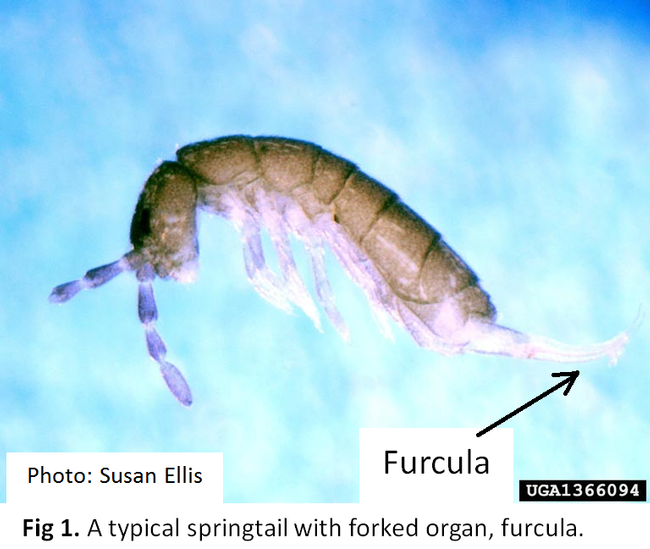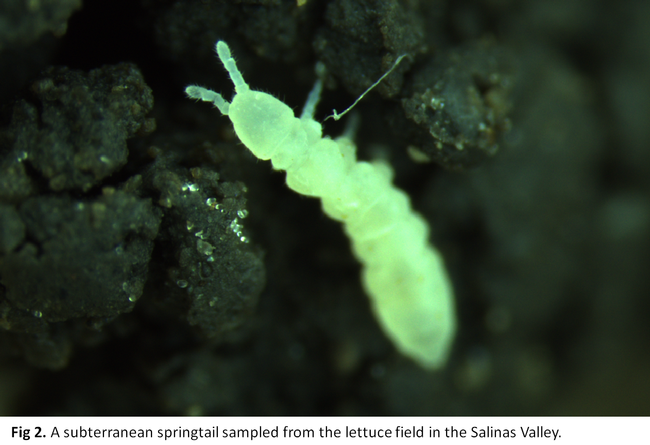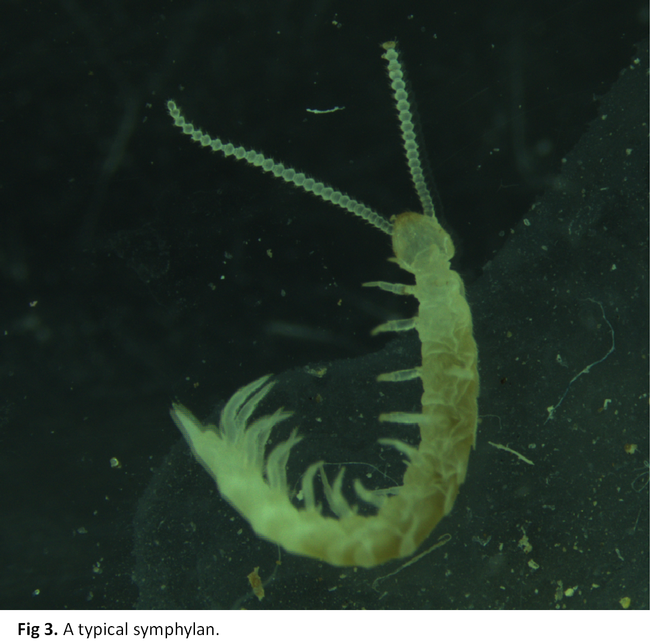Recently in the Salinas Valley, subterranean springtails (Family: Onychiuridae) have emerged as a serious pest of lettuce. These soil dwelling primitive insects primarily attack germinating lettuce seeds and young plants, reducing the plant vigor or cause death, which cause patchy or area-wide stand loss. Most springtails possess a forked organ (furcula) in the rear-end, which is extended forward and backward to jump (Fig. 1); hence, the common name, springtail. However, the springtail species, sampled from lettuce fields causing the stand loss, does NOT have furcula. This means they cannot jump. This springtail species is about 3 mm long, wingless, totally blind, possess 3 pairs of legs and short 4-segmented antennae and white/off-white in color (Fig. 2). Mouth parts of the springtail are mostly hidden within the head.
Springtails are generally considered as beneficial insects because they aid in the decomposition of the soil organic matter by feeding, which in turn improves soil health or structure. In addition, these insects feed on the soil dwelling fungal hyphae and spores. In the Salinas Valley, the cool weather in the spring slows the seed germination and decomposition of plant residues incorporated in the previous season (December). The slow seed germination or seedling growth, presence the ample organic matter, and sufficient soil moisture are the perfect recipe for rapid reproduction, leading to an outbreak in population of springtails. It is important to note that these insects are less affected by the cooler weather in the spring. This indicates that the slowly germinating seeds or tender plant tissue are likely vulnerable to being attacked by the sheer number of springtails in a given area.
It is likely that these white springtails are easily mis-identified as symphylans because of white color, tiny, and lack the ability to jump. Symphylans are NOT insects but centipede-like organisms. Unlike symphylans, which move into deeper profiles of the soil, springtails remain active in the top layer of the soil, provided sufficient moisture is present. Springtail population crashes once the top soil layer does not have sufficient moisture because they hardly move to lower depths of the soil profile. Symphyans are also white in color, but are highly mobile; possess 10-12 pairs of legs, and multi-segmented antennae (Fig. 3).
Monitoring for springtails is the key to determine presence and size of the population. It is suggested to deploy 4-8 potato or beet-root slices to detect presence of springtail before seeding at least 50 meters apart in the field. Although this technique is used to detect symphylan activity in the soil, it has been observed that these subterranean springtails are also attracted to potato or beet-root slices. Place the potato or beet-root slices after gently racking the surface soil and cover it with a bowl then put soil over it. After 2-3 days, check the slices for springtails. Preliminary data suggest that timing of insecticide application could reduce the stand loss. If the springtails are detected during the pre-seeding period on the potato slices, insecticide applications before seeding and/or at seeding could suppress the springtail populations to reduce stand loss. However, incidence of very high springtail populations at certain patchy areas may not get completely suppressed even with insecticide applications. Upon detection of higher population of springtails in the field yet to be planted, soil moisture management could reduce the population pressure. For further infomation please contact me at svjoseph@ucdavis.edu or (831) 759-7359. You could also see a video of this subterranean springtails in the recent AgNETWest radio report.


